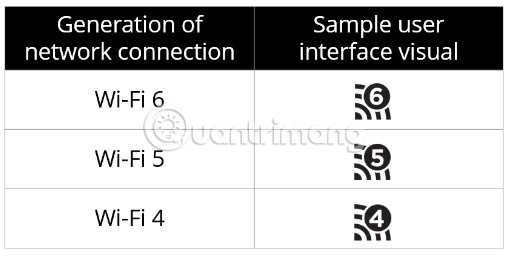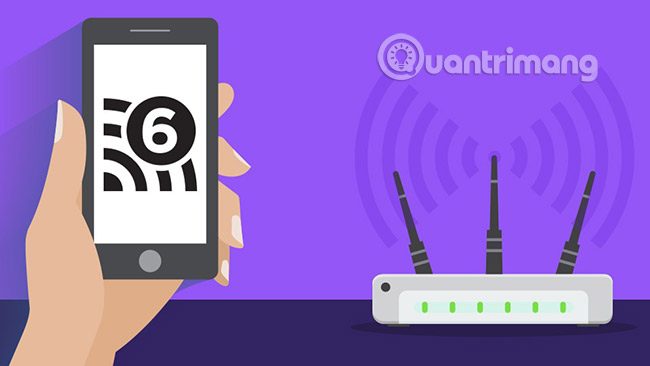Learn about Wi-Fi 6
Wi-Fi standards are always changing after a few years. A new standard means that the wireless network will become better, along with some new symbols that will appear on the packaging of the router or smartphone.
Wi-Fi Alliance does not want users to be bound by complicated technical symbols, so instead of just complying with IEEE's 802.11 naming scheme, the organization simplifies the Wi-Fi standard in its own way. . The next Wi-Fi standard is called Wifi 6. So what is Wi-Fi 6, compared to older Wifi standards? Let's look at TipsMake.com about Wifi 6 in this article.
Things you need to know about Wifi 6
- What is Wi-Fi 6?
- How is Wi-Fi 6 better?
- Upgrade MU-MIMO
- Better radio frequency, more channels
- More streams simultaneously
- When can users buy routers or wireless devices Wi-Fi 6?
- Should you upgrade to Wi-Fi 6?
What is Wi-Fi 6?
Wi-Fi 6 is the latest update to the wireless network standard. Wi-Fi 6 is based on the IEEE 802.11ax standard, with faster speeds, greater capacity and improved power performance compared to its predecessor 802.11ac (currently known as Wi-Fi 5).
According to the old naming standard, Wifi 5 is 802.11ac, while Wifi 6 will be 802.11ax. But the Wi-Fi Alliance has realized that changing the two letters behind does not give consumers much information about the new Wifi standard. Without technical knowledge, users may not understand 802.11n differently than 802.11ac.
Edgar Figueroa, president and CEO of the Wi-Fi Alliance, said: "For nearly two decades, Wi-Fi users have had to arrange technical naming conventions to determine if their devices have Wi-Fi Alliance, Wi-Fi Alliance is pleased to introduce Wi-Fi 6 and present a new naming plan to help industry and Wi-Fi users easily understand the Wi-Fi generation. New Fi, supported by their device or connection ' .
The new naming system will run in parallel with the current system. That is, the 802.11 naming convention is still in effect, but manufacturers can write both naming standards on their products. This, theoretically, makes it easier than ever to buy a new device with better connectivity.
This is how the respective standards are named:

- Wi-Fi 6: 802.11ax (expected to appear in 2019)
- Wi-Fi 5: 802.11ac (2014)
- Wi-Fi 4: 802.11n (2009)
- Wi-Fi 3: 802.11g (2003)
- Wi-Fi 2: 802.11a (1999)
- Wi-Fi 1: 802.11b (1999)
How is Wi-Fi 6 better?
As a general rule, the latest wireless standards provide users with faster data transfer rates. In theory, Wifi 6 delivers speeds up to 10Gbps, and reaches 12Gbps at the highest wireless broadcast frequency and at very short distances. This is a pretty big improvement in speed (30-40% increase compared to the old Wifi 5 standard).
It also brings some other noticeable improvements to the wireless network.

Upgrade MU-MIMO
Many new routers currently use MU-MIMO to provide a constant flow of data for many users. MU-MIMO technology was released to the market during the current Wi-Fi 5 period, on high-end routers (currently it also starts appearing on mid-range routers). With Wi-Fi 6 standard, allowing MU-MIMO omnidirectional (both uplink and downlink) will make MU-MIMO available on most new routers.
Better radio frequency, more channels
Another important feature of Wi-Fi 6 is Orthogonal Frequency Division Multiple Access - OFDMA. OFDMA uses 2 available transmission frequencies: 2.4GHz and 5GHz better.
Theoretically, this upgrade speeds up by dividing the usable spectrum into smaller units, thereby increasing throughput and network performance.
Currently, dual-band routers typically operate on 2.4GHz and 5GHz spectrums. In particular, these spectra allocate by channel with a width of 20MHz. These 20MHz channels are grouped together into 160MHz blocks.
All devices broadcast on a block in a certain spectrum. When multiple devices are using the same channel, on the same spectrum, in a restricted area, congestion will appear.
Wi-Fi 6 changes the allocation of these 20MHz channels into 256 separate sub-channels, a significant increase, compared to the current 64 channels. Not only does it increase in terms of the number of pure channels, Wi-Fi 6 also modifies data connections in those added channels.
In the past, all sub-channels were used in parallel to communicate with a connected device, meaning that a single device could monopolize the channel until it ceded the rights to another device.
Wi-Fi 6 allocates new additional sub-channels in the form of Resource units (RU) - Resource units. They are used for simultaneous communication with some 802.11ax devices. On a single channel can have 9 devices with effective communication, equivalent to 74 devices on a block of 160MHz.

More streams simultaneously
Another major change in the Wi-Fi 6 standard is the update to the current 256 Quadrature Amplitude Modulation (QAM) 802.11ac. Wi-Fi 6 increased to 1024 QAM, allowing broadcasting up to 8 streams simultaneously.
When can users buy routers or wireless devices Wi-Fi 6?
Some Wi-Fi 6 routers have begun to appear on the market, such as ASUS's TR-AX88U advertised as being ready to support new generation 802.11ax devices (although the actual results are difficult to evaluate). It uses AX6000's router standard, which means compliance with the new and best wireless specifications.
Netgear's Nighthawk AX8 is another Wi-Fi 6 router that you can buy at the present time. AX8 has a sleek face and the future promises to be a router with the same specification as AX6000. Both Netgear Nighthawk AX8 and Asus TR-AX88U have a throughput limit of about 6Gbps, and still have not reached the highest level of Wi-Fi 6 (about 10Gbps). This speed can only be achieved with the AX11000 standard router.
There are very few routers that use AX11000 specifications. TP-Link's brand of high-end Archer routers will have AX11000 routers in the near future. D-Link is also preparing to release AX11000 Ultra Wi-Fi router, gaming device maker Asus ROG will also launch Rapture GT-AX11000 to the market.
Should you upgrade to Wi-Fi 6?

Until this technology is more widely used, the answer is no. As you can see above, there are very few devices on the market that support Wi-Fi 6. It is also possible that the specifications will change, but it will only be minor tweaks to optimize performance. Well, because the fundamental part of the specification is basically completed.
Deciding to buy a new router at the moment is also a difficult decision. The advent of Wi-Fi 6 entailed the coming of WPA3, the new wireless security protocol. The widespread adoption of WPA3 will not be widespread quickly until the end of 2019.
With that information, it is highly recommended to check if the router you are about to purchase can receive a more secure WPA3 standard firmware update.
With Wi-Fi 6, the power of a network will be greatest when all devices follow this new standard. Rushing to buy a new Wi-Fi 6 router is absolutely unnecessary at this time.
However, if you need to buy a new router, you can refer to TipsMake.com's article about the best low-cost routers at the moment.
Wish you can choose the right product!
See more:
- 8 popular wireless technology standards today
- 5 popular and best Qi standard wireless charger today
- Unexpected items in the house silently "breaking" Wi-Fi waves
You should read it
- 7 best 802.11g wireless broadband routers
- How to secure the D-Link wireless router
- How to set a password for Wireless
- How to Set Up a Wireless Router
- How to Make a Regular Printer Wireless with a Wi Fi Router
- Which type of wireless router has the longest range?
- 5 advantages and disadvantages for 5GHz Wi-Fi router
- 5 reasons to upgrade to a Wi-Fi 7 router
May be interested
- How to come up with the best prompts to learn with ChatGPT
 how good the ai is depends on the prompts you give it. many people have been using chatgpt to learn since it was first released, but it wasn't until they tried these prompts that it completely changed the way they studied.
how good the ai is depends on the prompts you give it. many people have been using chatgpt to learn since it was first released, but it wasn't until they tried these prompts that it completely changed the way they studied. - How to Learn Aerobatics
 if you have been to an air show and seen pilots perform daring loops and rolls, you know how fascinating and complex it is. understand that it takes actual flying lessons to learn how to do aerobatics, as it is extremely dangerous to learn...
if you have been to an air show and seen pilots perform daring loops and rolls, you know how fascinating and complex it is. understand that it takes actual flying lessons to learn how to do aerobatics, as it is extremely dangerous to learn... - How to learn English via Flashcard on AnkiDroid
 ankidroid supports you to create smart cards to learn foreign languages on your phone with many other interesting features.
ankidroid supports you to create smart cards to learn foreign languages on your phone with many other interesting features. - How to learn English with ChatGPT
 chatgpt is a truly versatile tool for anyone learning english. here is a detailed guide on how to learn english using chatgpt.
chatgpt is a truly versatile tool for anyone learning english. here is a detailed guide on how to learn english using chatgpt. - How to Learn Faster
 in order to adapt more quickly to the rapidly changing environments in which we live, we need to learn more effectively and efficiently. this article is intended to describe some basics for meta-learning, or learning about learning, to...
in order to adapt more quickly to the rapidly changing environments in which we live, we need to learn more effectively and efficiently. this article is intended to describe some basics for meta-learning, or learning about learning, to... - How to learn English on Chrome through the Rememberry utility
 rememberry utility on chrome will help you learn english through the ability to translate languages, learn english words through word cards and test.
rememberry utility on chrome will help you learn english through the ability to translate languages, learn english words through word cards and test. - How to Alphabetize in Microsoft Word
 alphabetizing lists is a good skill to learn in word, especially if you find yourself dealing with directories and lists often. luckily, the sorting process is quite simple once you learn how to access it. follow this guide to learn how...
alphabetizing lists is a good skill to learn in word, especially if you find yourself dealing with directories and lists often. luckily, the sorting process is quite simple once you learn how to access it. follow this guide to learn how... - To be good at English, don't forget to visit these 13 YouTube channels every day
 in addition to movies, youtube is also a resource repository that any english learner cannot ignore. if you only think of funny videos, advertisements, documentaries or music videos of all genres, you have ignored the great learning materials on this planet's largest video sharing social network. there.
in addition to movies, youtube is also a resource repository that any english learner cannot ignore. if you only think of funny videos, advertisements, documentaries or music videos of all genres, you have ignored the great learning materials on this planet's largest video sharing social network. there. - Learn the first Python program
 in this article we will learn a simple python program to get a little more insight into python, before starting to learn about the main components of this programming language.
in this article we will learn a simple python program to get a little more insight into python, before starting to learn about the main components of this programming language. - The secret to help you achieve what you want without wasting time
 when trying to accomplish something bigger, you can answer the question of why but don't know how (how)? you feel confused because you don't know which direction will help you achieve those goals? this is the solution!
when trying to accomplish something bigger, you can answer the question of why but don't know how (how)? you feel confused because you don't know which direction will help you achieve those goals? this is the solution!










 The best IPAM software and tool to manage IP addresses
The best IPAM software and tool to manage IP addresses The best network configuration management tools and software
The best network configuration management tools and software How to set Ethernet or Wi-Fi as the default option on a Mac
How to set Ethernet or Wi-Fi as the default option on a Mac Where does Super WiFi long-range exist?
Where does Super WiFi long-range exist? Compare 4 types of security WiFi WEP, WPA, WPA2 and WPA3
Compare 4 types of security WiFi WEP, WPA, WPA2 and WPA3 The difference between Tethering and Hotspot
The difference between Tethering and Hotspot